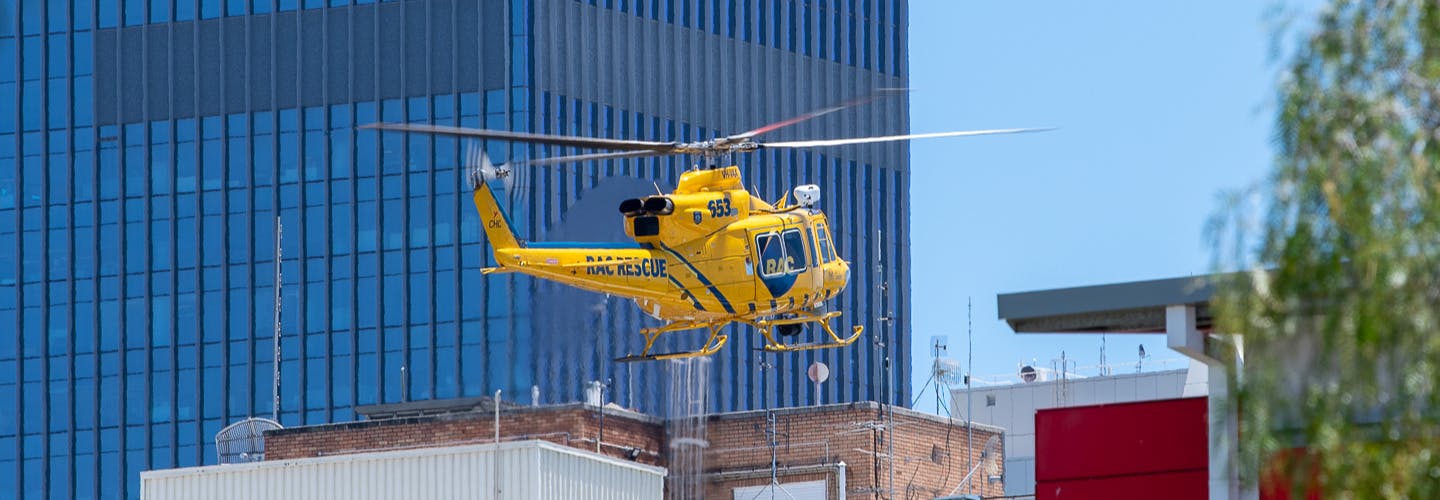FAQs
- Royal Perth Hospital (RPH) is the designated provider of major trauma services for adults in Western Australia (WA).
- There is a need for dedicated flight paths to the minimise risk to community, property and those accessing the State Major Trauma Unit at RPH.
- Protection of the emergency flight paths is important as ongoing development proposals of a significant scale in proximity to RPH will limit the flight path directions and options.
- The flight paths will provide safe access for the Emergency Rescue Helicopter Service and those onboard, including pilots and patients in an emergency situation.
- The on-site location of the new helipad (opened in 2022) aligns with the WA State Trauma System objective of optimum speed from injury to specialist trauma treatment, which in turn increases a patient's chances of survival and recovery.
- More than 75,000 patients are admitted to RPH annually.
- 700 people are classed as a major trauma suffering complex injuries requiring care from multiple medical specialists. For helicopter operations, 70.4% of patients transported by way of the Emergency Response Helicopter Service are taken to RPH for specialist treatment.
- The federal government through the Department of Infrastructure, Transport, Regional Development and Communications has determined the need to protect airspace for strategically located Helicopter Landing Sites to minimise impacts from future buildings and structures (including construction cranes) throughout Australia.
- Since 2017, a number of flight path options have been investigated, linked to the new helicopter landing site location.
- There has been extensive consultation with key stakeholders, including City of Perth, City of Vincent, Department of Planning, Lands and Heritage, and Development WA to consider technical implications associated with the proposal.
- Further, detailed consultation and technical inputs have been undertaken with Department of Fire and Emergency Services, CHC Helicopters, an aeronautical consultant, East Metropolitan Health Service and town planning consultants.
- The proposed flight paths (subject of the proposed scheme amendment) have been determined to be the most appropriate alignment with respect to critical safety and flight requirements, strategic land use planning and minimising the impact to existing development potential of properties.
- Apart from critical safety and flight requirements, the flight path alignments have been chosen to minimise the overall impact on properties surrounding RPH as far as practically possible.
- A small number of properties will be impacted and may need to consider an alternative development approach. The large extent of properties locating within the flight paths will not be impacted by them.
- The small number of property owners who will be impacted by the flightpaths will be engaged directly as part of the Scheme Amendment consultation process.
- The location of the flight path largely sits within the City of Perth’s local government area, however, a small section does encroach within the City of Vincent.
- An Amendment to the City of Vincent’s Local Planning Scheme will also be required to protect the flight path alignment.
- The flight path alignment is proposed to be protected by an amendment to the local planning schemes of City of Perth and City of Vincent.
- A Scheme Amendment has been initiated by both the City of Perth and the City of Vincent.
- The next steps of the process require the Amendments to be referred to the Environmental Protection Authority and the Western Australian Planning Commission to determine whether it needs formal environmental impact assessment and can proceed through a Complex Amendment advertising process.
- Once confirmed the Amendment is suitable to be advertised, a public consultation period will be undertaken inviting affected stakeholders, landowners, occupiers and the wider community to make a submission to the respective local government authority.
- Once all submissions have been considered, the final Scheme Amendment, together with an assessment of the submissions received during the consultation period, will be presented to each Council for Final Adoption. After Final Adoption the Amendments will then be presented to the Hon. Minister for Transport, Planning and Ports for approval.
Why do we need an emergency flight path?
What happens now in relation to access by helicopters to RPH?
How was this flight path determined?
How does this impact on my property?
Does this flight path affect the City of Vincent properties?
What is involved in the Scheme Amendment process?
